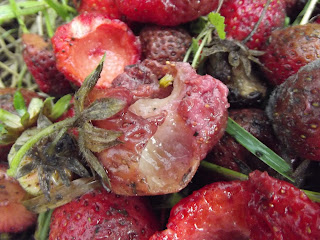At the beginning of the season I wrote about strategies for coping with drought and hosepipe bans. Hmm. Now, after two record-breakingly wet months, and amidst what is likely to become a third, I think it's time to start calling summer in Britain 'the wet season' and adjusting our practices to match, don't you? I've already talked about flooding, here, but what else can we do in future to improve the health of our plants when the sun don't shine?
1 - Look after your soil
Organic matter is a must for healthy soil; not only does it
retain moisture to protect plants from drought, but it improves
drainage too, by providing a more open soil structure. Dig it in early in the
season, or spread it on top and let the worms do the work. Organic
matter is even more important in heavy clay soils, which waterlog
easily. To improve drainage even more, create a lighter soil by
adding sand.
2 - Plan for good drainage
Raised beds are the ultimate in improved drainage for veg crops - assuming of course they are filled with good, well-draining soil. It can also be useful to plant on mounds or ridges. Aerate soil by spiking it to help drainage and drying. There is debate about whether crocks or stones in the bottoms of pots actually help or hinder drainage - scientists say they hinder it - but one thing we must certainly do is make sure there are enough drainage holes in our pots and make sure they stay clear. Raising containers off the ground on bricks or stones will also help. If you have a serious problem, consider a drainage trench or soakaway, filled with rubble or gravel, to carry water away. You can leave it open or top it with plastic sheeting and cover with soil.
3 - Restore nutrients
Excessive watering can leach nutrients out of the soil and leave plants hungry, so be sure to feed them regularly. Liquid feed, though, may do more harm than good in a very wet container! Blood, fish and bone is a great all-round dry feed which you can just sprinkle on the soil and allow the rain to water in gently, or work into the top few inches of damp soil. Rock dust is a highly recommended soil 'remineraliser', which I've just begun experimenting with this year - they say it improves plant health and yields dramatically... Seaweed is another good all-round plant-booster, that stimulates and strengthens plants against all problems. It can be watered in or used as a foliar feed on dry days.
4 - Protect your plants
I know I'm always whinging about not having a greenhouse, but this year it would have been more useful than ever. Cucumbers and gherkins dropped dead in the gloom and even cool-weather peas and asparagus grew painfully slowly. A little cover to intensify what few UV rays we've had would probably have been a great benefit. If this wet-summer trend continues, I think growing under glass or plastic will become more and more important, and I will certainly try to grow my cucumbers under cover after this year. Others that would benefit from it are tomatoes of course, French beans, peppers and chillies, strawberries and asparagus. Rosemary hates being wet, and I have moved mine into the mini-greenhouse where my aubergines and West Indian gherkins are already thriving. Oh, how I dream of my very own polytunnel... On another note, just like mulch can help in drought conditions by preventing evaporation, it can help in wet weather by absorbing some of the water before it reaches the soil. Use an impenetrable mulch such as plastic over the roots of waterlogged plants, or something absorbent such as straw or newspaper as a general cover, and pull it back on sunny days to let things dry out!
5 - Defend against pests and diseases
Keep on top of pruning, staking and mulching to keep plants off wet soil and improve ventilation - this will lessen the risk of fungal diseases. And be prepared for slugs and snails, which thrive in wet conditions. Hand-picking, beer traps, barriers of copper/tinfoil/eggshell/ash/sand, decoy plants (French marigolds are good), wheat bran, nematodes and organic pellets are all methods worth considering, and a combination of several of these is best! Encourage natural predators such as ground beetles, amphibians, hedgehogs and ground-feeding birds (thrushes, robins, blackbirds, starlings) by providing food and undisturbed habitats for them. Perhaps there is an opportunity to alter your landscaping to draw excess
water to a pond or bog garden, and make the most of the excess water to
encourage wildlife! Slugs also struggle to feed on high-up plants, so climbing plants are less at risk, as are those on roofs and windowsills.
6 - Pollinate
Rain keeps pollinating insects at home indoors, and pollination of my tomatoes in particular has been very poor so far this year. Tomatoes and peppers are self pollinating and only require a shake or a flick on the back of the flower to pollinate them. Others can be carefully hand-pollinated using a soft paintbrush.
What about you? How do you plan to improve things for your crops if next season is as wet and gloomy as this one?


3 comments:
The problem is that if you design your garden/plot to cope with wet conditions you are really up the creek when we have a dry season like last year and vice versa!
I'm not so sure - most of the principles work both ways, especially nurturing healthy soil, mulching etc. Last year wasn't that dry - we had a dry spell early on but then it still rained a lot through mid- and late-summer.
It was really dry last year for us. December was the first month to have a reasonable amount of rain and then Feb and March were dry again. Now its just the opposite.
Post a Comment